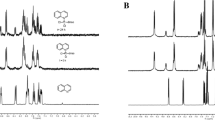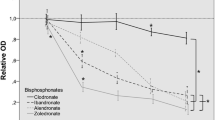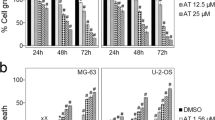Summary
Two new aromatic bis-(2-chloroethyl)-amino derivatives (BCMP and BAD) which are linked to osteotropic bisphosphonates were investigated for their therapeutical efficacy in rat osteosarcoma. Furthermore their genotoxic potential in vitro was determined in S. typhimurium and in mammalian cells. Finally, parameters for toxicity and genotoxicity were determined in liver and bone marrow cells following in vivo treatment. It was shown that BAD was of higher therapeutic effectiveness than BCMP. Both compounds induced approximately a two fold increase of his+ revertants in S. typhimurium TA1535 following metabolic activation by subcellular liver fractions. Both compounds also induced amplification of SV40 DNA in SV40 transformed cells (CO631). This endpoint may be of importance for acquired resistancy of cells during therapy. DNA-single strand breaks were induced by BCMP but not by BAD in liver cells and CO631 cell line. Following in vivo treatment BCMP was of higher genotoxic activity in liver cells than BAD. In comparison, genotoxicity of both compounds was much lower in bone marrow cells than in liver cells. BCMP was again more potent than BAD in inducing DNA single strand breaks, whereas BAD was more toxic. The higher therapeutic efficacy of BAD together with its lower genotoxic properties makes this compound superior to BCMP as a candidate for applied chemotherapy in humans.
Similar content being viewed by others
References
Wingen F, Sterz H, Blum H, Möller H, Pittermann W, Pool BL, Sin HJ, Spring H, Schmähl D: Synthesis, antitumor activity, distribution and toxicity of 4-[4-[Bis(2-chloroethyl) amino] phenyl]-1-hydroxybutane-1,1-bisphosphonic acid (BAD), a new lost derivative with increased accumulation in rat osteosarcoma. J Cancer Res Clin Oncol 111:209–219, 1986
Frijlink WB, Bijvoet OLM, Te Velte, Heynen G: Treatment of Pagets disease with (3-amino-1-hydroxypropylidene)-1, 1-bisphosphonate (A.P.D.). Lancet I:799–803, 1979
Wingen F, Eichmann T, Manegold C, Krempien B: Effects of new bisphosphonic acids on tumor-induced bone destruction in the rat. J Cancer Res Clin Oncol 111:35–41, 1986
Jung A, Fleisch H: Les diphosphonates dans le traitement des metastases osseuses. Schweiz Med Wochenschr 111: 1878–1882, 1981
Elomaa I, Blomquist C, Gröhn P: Long term controlled trial with diphosphonate in patients with osteolytic bone metastases. Lancet 1:146–149, 1983
Wingen F, Schmähl D: Distribution of 3-amino-1-hydroxypropane-1,1-diphosphonic acid in rats and effects on rat osteosarcoma. Arztneimittelforschung/Drug Research (II)10: 1565–1571, 1985
Guaitani A, Polentarutti N, Filippeschi S, Marmoti L, Corti F, Italia C, Coccioli G, Donelli MG, Mantovani A, Gerattini S: Effects of disodium etidronate in murine tumor models. Eur J Cancer Clin Oncol 20:685–693, 1984
Maron DM, Ames BN: Revised methods for the Salmonella mutagenicity test. Mutation Res 113:173–215, 1983
Sina JF, Bean CL, Dysart GR, Taylor VI, Bradlay MO: Evaluation of the alkaline elution/rat hepatocyte assay as a predictor of carcinogenic/mutagenic potential. Mutation Res 113:357–391, 1983
Pool BL, Eisenbrand G, Preussmann R, Schlehofer JR, Schmezer P, Weber H, Wiesler M: Detection of mutations in bacteria, as well as DNA damage and amplified DNA sequences in mammalian cells as a systematic test strategy for elucidating biological activities of chemical carcinogens. Fd Chem Toxicol 24:685–691, 1986
Lavi S: Carcinogen-mediated activation of SV40 repliciens: a modul system for initiation of carcinogenesis. In: RT Schimke (ed) Gene amplification. Cold Spring Harbor Laboratory, Cold Spring Harbor, N.Y., 1982, p 225–230
Schimke RT: Gene amplification in cultured animal cells. Cell 37:705–713, 1984
Frei E, Pool BL, Glatt HR, Gemperlin-Mertes I, Oesch F, Schlehofer JR, Schmezer P, Weber H, Wiessler M: Determination of DNA single strand breaks and selective DNA amplification by N-nitrodimethylamine and analogs, as well as estimation of the indicator cells' metabolic capacities. J Cancer Res & Clin Oncol 111:123–128, 1986
Nicolini C, Cavanna M, Maura A, Pino A, Robbiano L, Biassoni F, Ricci R, Belmont A, Zietz S, Brambilla G: DNA alkaline elution: Physical basis of the elutionprocess and validation of this method as a screening procedure to identify chemical carcinogens. In: C Nicolini (ed) Chemical Carcinogenesis, Methods in Cancer Research Vol XVI. Plenum Press, New York, 1982, p 93
Parodi S, Pala M, Russo P, Zunono A, Balibi C, Albini A, Valerio F, Cimberle MR, Santi L: DNA damage in liver, kidney, bone marrow, and spleen of rats and mice treated with commercial and purified aniline as determined by alkaline elution assay and sister chromatid exchange induction. Cancer Research 42:2277–2283, 1982
Iscove NN, Sieber F: Erythroid progenitors in mouse bone marrow detected by macroscopic colony formation in culture. Exp Hematol 3:32–43, 1975
Bedford P, Berger MR, Eisenbrand G, Schmähl D: The level of DNA interstrand crosslinking in bone marrow parallels the extent of myelosuppression in mice treated with four chloroethylnitrosoureas. J Cancer Res Clin Oncol: 141–147, 1984
Denkel E, Pool BL, Schlehofer JR, Eisenbrand G: Biological activity of N-nitro-diethanolamine and of potential metabolites which may arise after activation by alcohol dehydrogenase in Salmonella typhimurium, in mammalian cells, and in vivo. J Cancer Res Clin Oncol 111:149–154, 1986
Brambilla G, Cavanna M, Parodi S: Evaluation of DNA damage and repair in mammalian cells exposed to chemical carcinogens. Methods potentially useful as short term prescreening tests. Pharmacol Res Commun 10:693, 1978
Wingen F, Schmähl D, Berger MR, Spring H: Intraosseously transplantable osteosarcoma with regularly disseminating pulmonary metastases in rats. Cancer Letters 23:201–211, 1984
Wingen F, Weber E: Changing metastatic patterns of a transplantable rat osteosarcoma. Clin Exp Metastasis 5, 1:17–26, 1987
Ames BN, McCann J, Yamasaki E: Methods for detecting carcinogens and mutagens with Salmonella mammalian microsome mutagenicity test. Mutation Research 31:347–364, 1975
Bradley MO, Dysart G, Fitzsimmons K, Harbach R, Lewin J, Wolf G: Measurements by filter elution of DNA single-and double-strand breaks in rat hepatocytes: Effects of nitrosamines and irradiation. Cancer Research 42:2592–2597, 1982
Romruen K, Pool BL: Metabolic activation capabilities of S9 and hepatocytes from uninduced rats to convert carcinogenic N-nitrosamines to mutagens. Mutation Res 140:147–153, 1984
Henne Th, Berger MR: Comparison of DNA damage in various tissues, myelosuppression and serum levels of transaminases and bilirubin in tumor-bearing female Sprague-Dawley rats treated with 1-(2-hydroxyethyl)-3-(2-chloroethyl)-3-nitrosourea (HECNU). J Cancer Res Clin Oncol 111:75–78, 1986
Kohn KW, Ewing RAG, Erickson LC, Zwelling LA: Measurement of strand breaks and cross-links by alkaline elution. In: EC Friedberg, PC Hanawalt (eds) DNA Repair, a Laboratory Manual of Research Procedures. Marcel Dekker, N.Y.:379–401, 1981
Lavi S, Etkin S: Carcinogen-mediated induction of SV40 DNA synthesis in SV40 transformed Chinese hamster embryo cells. Carcinogenesis 2:417–423, 1981
Pool BL, Weber H, Schmezer P, Schlehofer JR: Induction of SV 40 DNA amplification in SV 40 transformed hamster cells. Limitations and capacities of a new short term test system for analysis of chemical carcinogens. In press 1987
Weber E: Survival-Statistische Auswertung biomedizinischer Daten, Teil II, Deutsches Krebsforschungszentrum Heidelberg, 1982
Schmezer P: Induktion von DNS-Einzelstrangbrüchen durch organspezifische Nitro-samine in primären Hepatozyten. Inter- und intra-Speziesvergleich. Dissertation in preparation at the biological Faculty of the Ruprecht-Karl-University, Heidelberg, FRG
Link MP: Adjuvant therapy in the treatment of osteosarcoma. In: VT De Vita, S Hellmann, SA Rosenberg, IB Lippincott (eds) Important advances in oncology. Company, Philadelphia.
Meyer WH, Shell MJ, Kumar M, Rao BN, Green AA, Champion I, Pratt CB: Thoracotomy for pulmonary metastatic osteosarcoma. Cancer 59:374–379, 1987
van Putten LM, Lelieveld P, Kram-Idsenga LKJ: Cell-Cycle specificity and therapeutic effectiveness of cytostatic agents. Cancer Chemother Rep 56, 1972
Schimke RT: Methotrexate resistance and gene amplification. Cancer 57:1912–1917, 1986
Kleinberger T, Etkin S, Lavi S: Carcinogen mediated methotrexate resistance and dihydrofolate reductase amplification in Chinese hamster cells. Mol Cell Biol 6:1958–1964, 1986
Schmähl D: Carcinogenicity of anticancer drugs and especially alkylating agents. In: D Schmähl, JM Kaldor (eds) IARC Nr. 78:29–35, 1986
Author information
Authors and Affiliations
Rights and permissions
About this article
Cite this article
Pool, B.L., Berger, M., Schlehofer, J.R. et al. In vivo and in vitro investigations on biological effects of aromatic bis-(2-chloroethyl)amino-bisphosphonic acids, new agents proposed for chemotherapy of bone tumors: cytostatic activity in rat osteosarcoma; toxicity and genotoxicity in liver and bone marrow; mutagenicity in S. Typhimurium. Invest New Drugs 6, 67–78 (1988). https://doi.org/10.1007/BF00195363
Issue Date:
DOI: https://doi.org/10.1007/BF00195363




